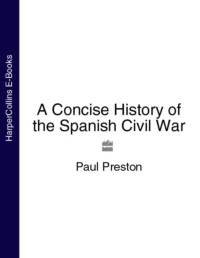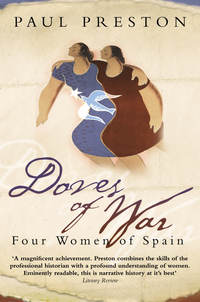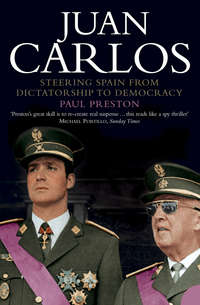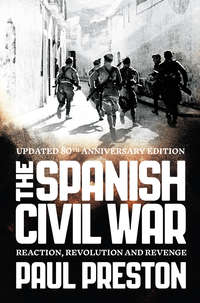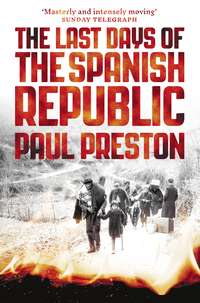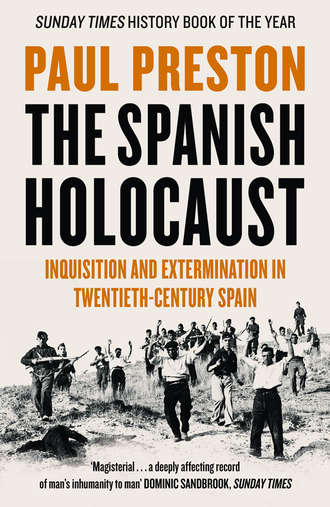
Полная версия
The Spanish Holocaust: Inquisition and Extermination in Twentieth-Century Spain
The enemy who burns alive entire families, who crucifies and burns alive the Bishop of Sigüenza in a town square, who cuts open the bellies of pregnant women, who murders innocent children, who steals, attacks buildings, burns, stains the honour of defenceless virgins, throws two hundred and fifty people into pits in Constantina and then throws in dynamite to finish them off, cannot and must not plead for mercy before those who would be his first victims if he got the chance.
Gutiérrez Prieto was shot on 11 August. To silence opposition to his execution, thirty inhabitants of Palos, including his uncle, were shot, along with twelve people from other towns. In Moguer, the arrival of the rebels unleashed a sweeping and well-planned repression that saw the homes of Republicans looted and women raped and claimed the lives of 146 people, including women and twelve-year-old boys. More than 5 per cent of the adult male population was murdered.77
In the light of Haro Lumbreras’s declaration, it is worth recalling that the total number of right-wingers assassinated in the province from 18 July until it was totally in rebel control was forty-four, in nine locations. A further 101 died in armed clashes with the defenders of the Republic. The subsequent repression was of a different order of magnitude, not a vengeful response to prior left-wing violence but the implementation of a plan for extermination. In seventy-five of Huelva’s seventy-eight towns, a total of 6,019 were executed.78 In the days between the military coup and the fall of Huelva to the rebels, the Republican authorities had made every effort to protect those rightists arrested in the immediate wake of the military coup. There had been calls for serenity and respect for the law from the Civil Governor, the Mayor, Salvador Moreno Márquez, and Republican and Socialist parliamentary deputies for the province. One hundred and seventy-eight local extreme rightists, including Falangists and the most hated landowners and industrialists, were arrested. All were safe and well when the city was conquered. However, during the previous eleven days, six people were murdered. This was the only excuse that Haro Lumbreras needed to launch a bloody repression. There were nightly shootings without even the farce of a ‘trial’. Many of those of the right who had been saved by the Republican authorities protested. Haro was eventually removed on 6 February 1937 when it came to light that he had misappropriated donations of jewellery and money made to the rebel cause. Specifically, it appeared that he had used these funds to pay for the services of prostitutes. Evidence was produced showing that, over the previous fifteen years, he had frequently been guilty of theft and other abuses of his position. When he left Huelva, his luggage, carried in three trucks, consisted of ninety-three trunks and suitcases. After serving in Zaragoza, Teruel and Galicia, he became head of the Civil Guard in León. He was killed on 16 February 1941 by one of his junior officers. It was rumoured that the young man’s wife had been the unwilling object of Haro’s attentions.79
In Seville, as in Huelva, the ‘the red terror’ was a much exaggerated justification for the repression, often no more than a contrived and feeble excuse. That the savagery visited upon the towns conquered by Spanish colonial forces was a repetition of what they did when they attacked a Moroccan village was proudly recognized by the rebels themselves. The first town taken by Castejón’s column was Alcalá de Guadaira to the south-east of the provincial capital. His official chronicler, Cándido Ortiz de Villajos, said of Castejón’s men recently arrived from Morocco that it was as if ‘they had brought with them, as well as the determination to fight for the salvation of Spain, the deadly, terrible, fatal and efficacious principles of the justice of the Qur’an’.80 The crimes during the four days of the so-called ‘red domination’ were cited to justify the repression carried out by the column. Among these ‘crimes’ was the death on the night of 17 July of Agustín Alcalá y Henke, one of the town’s principal olive-producers. A moderate and socially conscious Catholic, Alcalá y Henke had a long-term rivalry with another landowner, Pedro Gutiérrez Calderón, a supporter of the military uprising. Moreover, other employers had been infuriated when Alcalá y Henke had urged them to meet the demands of striking workers in the olive industry. He was shot by an unknown assassin. Many believed that he had been eliminated for betraying the employers’ interests and/or as an expendable victim to justify the imminent coup. When news of the military coup reached the town, a Popular Front Committee established under the chairmanship of the Mayor immediately appealed for calm. Since the local Civil Guard had pledged its loyalty to the Republic, it was not disarmed.81
However, against the wishes of the Committee, the anarchist CNT–FAI organized a militia force. Two churches, a convent and seminary were set on fire and some religious images destroyed. Three private houses and three right-wing clubs had been searched and property thrown into the street – a situation eagerly exploited by criminal elements. Between 19 and 21 July, the Committee had detained thirty-eight right-wingers for their own protection. None was harmed and there were no more deaths after Alcalá y Henke. Anarchist efforts to burn the municipal jail were successfully repelled. When Castejón’s column reached Alcalá de Guadaira in the early evening of 21 July, it was joined by the local Civil Guard. The town fell after a successful artillery bombardment by Alarcón de la Lastra. In the words of his enthusiastic chronicler, ‘all the Communist leaders were killed while Castejón punished or rather liberated the town of Alcalá’. ‘Punishment’ was the Africanista euphemism for savage repression. The alleged ‘Communist leaders’ were actually four unconnected individuals. Three were shot by the advancing column: two of them young men who had come from Seville to buy bread and the third an agricultural labourer who ran in panic when he saw the Legionarios. The fourth was Miguel Ángel Troncoso, the head of the local police, who, according to his son, was shot in the town hall by Castejón himself. None could be remotely described as Communist leaders. Thirteen men captured in the town hall were taken to Seville, where at least six of them would be killed. Alcalá de Guadaira was then left in the hands of local rightists and a process of revenge began which saw the murders of a further 137 men. Another 350 were imprisoned and tortured, many of whom died. The belongings of the murdered and imprisoned were stolen by the new masters of the town.82
In Carmona, to the east of Seville, local landowners bitterly resented the intense pressure put on them to accept work and wage agreements with their labourers. When news arrived of the coup, the Mayor was on official business in Madrid. A Defence Committee was set up with representatives of the Socialist and Communist parties, the CNT and the moderate liberal party Unión Republicana – the latter being the Municipal Police chief, Manuel Gómez Montes. The commander of the Civil Guard, Lieutenant Rafael Martín Cerezo, and Gómez Montes helped the Popular Front Committee gather available weapons and assign groups to defend the roads leading into the town. A convent was ransacked, but the nuns were evacuated unharmed.
On 21 July, a company of Regulares, accompanied by a local right-winger, Emilio Villa Baena, attempted to take the town. Initially repelled, the Moorish mercenaries took refuge in the town theatre with nineteen hostages. They then sent Villa Baena and three prisoners to negotiate a truce. Just as he began to negotiate with members of the Committee, Villa Baeza was shot by an anarchist from Constantina. The column withdrew back to Seville using the other sixteen hostages as human shields. The Committee now searched the houses of the town’s rightists and, in one of them, found six cases of pistols. Eighteen right-wingers were locked in the cellars of the town hall. A landowner was shot dead when he tried to flee over the rooftops. That night, in his broadcast, Queipo de Llano gave a wildly exaggerated account of these events, followed by a horrifying threat:
Faithful to their usual tactics, the Regulares repelled the aggression with such terrible violence that they left about one hundred dead and wounded among their aggressors. This madness is suicidal since I guarantee that Carmona will soon be punished as the treachery of its citizens deserves … the outrages they have committed against men and women of the right must be severely punished. Things have been done in Carmona that call for exemplary punishments and I will impose them in a way that will make history and will ensure that Carmona will long remember the Regulares.83
The following day, after first being bombed three times, the town was attacked by two substantial columns commanded by Major Emilio Álvarez de Rementería, accompanied by the bullfighter Pepe el Algabeño. The first, equipped with two artillery pieces and a section of machine-gunners, consisted of Regulares, Legionarios and Civil Guards, the second of Falangists. Cannon and machine-gun fire dispersed the poorly armed defenders and the town was captured quickly. That day, twelve were killed, their demise later registered as ‘violent death’. Over two hundred people fled. Lieutenant Martín Cerezo was arrested and shot and his replacement set about avenging the two deaths of Emilio Villa and Gregorio Rodríguez. Over the next four months, he ordered the executions of 201 men, some of them barely in their teens and others past retirement, and sixteen women. There were no trials and the only ‘legal’ veneer was an airy reference to the edict of martial law. Where men had fled, their relatives were shot. In many cases, after the heads of families were killed, their houses were confiscated and their wives and young children thrown on to the street. Another seventeen people from Carmona were executed in Seville and Málaga. Large numbers of men were conscripted into the rebel forces.84
The victims were largely selected by the local caciques, because they were known to be Republicans or union members or had shown disrespect. One man was shot because he was the bill poster who had stuck up left-wing election posters in February 1936. As in virtually every conquered town in the south, women had their heads shaved, were given castor oil to make them soil themselves and, led by a brass band, were paraded around the streets to be mocked.85 The perpetrators of the murders and the other abuses included Civil Guards and estate employees who had swiftly joined the Falange. Their motives ranged from psychotic enjoyment to money, some boasting of being paid 15 pesetas for every killing. For others, involvement reflected gratitude for patronage received or shared religious views, as well as shared fears and anger. They all perceived savagery as ‘services for the Fatherland’. Men and women, and many teenagers, were arrested either by the Civil Guard or by the Falangists. Sometimes, victims were picked up at random, or because these thugs coveted their wife or their property, or simply because they were bored or drunk. Sometimes those arrested were shot immediately, sometimes taken to jail where they were beaten and tortured before being eventually murdered. After the shootings, the caciques, the recent Falangist converts and the younger landowners would meet in a bar and comment with satisfaction that there would be no more wage claims from those just despatched. On one occasion, unable to find a young man who in fact was hiding under the floor of his parents’ shack, they burned down the dwelling with all three inside.86
When the parish priest of Carmona protested at the murders, he was told that those executed had been found guilty by a tribunal consisting of the local landowners. When he pointed out that this did not constitute any kind of legal process, he was threatened. By 1938, those responsible experienced sufficient guilt to feel the need to falsify the circumstances of the murders committed in 1936. Witness statements to the ‘tribunal’ were fabricated, apparently ‘justifying’ the shootings. Many deaths were registered as having been caused by ‘military operations in the town’. Nevertheless, there were more executions when those who had fled came back at the end of the war.87
In Cantillana, a wealthy farming community to the north-east of Seville, there had been little history of social tension despite stark inequalities in landownership (four men owned more than 24 per cent of the land, and one of them over 11 per cent, while three-quarters of the farmers owned only 6 per cent). In the wake of the military coup, an Anti-Fascist Popular Front Defence Committee administered the town under the Socialist Mayor. The nearest to revolutionary drama was the use of clenched-fist salutes and greetings such as ‘Salud camarada’; firearms were confiscated from landowners and fines were imposed on those who refused to take on unemployed labourers. To guarantee the feeding of the town, wheat and cattle were requisitioned without compensation. The owners were furious but otherwise unmolested. Rich and poor alike were given rations as was the local Civil Guard contingent, which had been confined to its barracks. Only one man was arrested on suspicion of being in cahoots with the military conspirators. A few houses were looted and, on 25 July, the parish church was set alight although the priest was unharmed.
A substantial column of Legionarios, Falangists and Requetés sent by Queipo de Llano was gradually moving north-eastwards up the Valley of the Guadalquivir, taking town after town. They appeared in Cantillana at midday on 30 July. After the usual artillery bombardment, they entered the town unopposed. The defenders had only a few shotguns and soon the surrounding fields were thronged with people fleeing. Despite having been well treated, the local Civil Guard commander began the first of around two hundred executions without trial. Large numbers of townspeople were imprisoned and, over the next few months, more than sixty people including three women and the Mayor would be taken away and shot in Seville. After the Civil War, the parish priest of Cantillana was removed in punishment for a sermon in which he said: ‘If the church is damaged, it can be repaired; if statues have been burned, they can be replaced; but the husband or son who has been killed can never be replaced.’88
In his broadcast of 30 August, Queipo declared that the search for Republican criminals would go on for ten or twenty years. He also claimed that, in the rebel zone, there had been no atrocities. With no sense of irony, he reiterated his view that any killing done according to his edict was therefore legal: ‘We might shoot someone who committed crimes but no one could possibly say that in any town, anywhere, a single person had been murdered. Those responsible have been shot without hesitation. This was done following the dictates of the edict not for the fun of killing like they did, with the greatest cruelty, burning people alive, throwing them into wells and dynamiting them, putting out people’s eyes, cutting off women’s breasts.’89
In fact, what is known of such broadcasts by Queipo de Llano derives from the following day’s press reports, together with occasional snippets noted down by those who heard them. Comparisons, when possible, between the two suggest that the texts printed by the press were a pale reflection of the obscenity of the originals. Newspaper editors knew better than to print the more outrageous incitements to rape and murder. Indeed, there was concern that Queipo’s excesses might be damaging to the rebel cause abroad. Accordingly, the instinctive self-censorship of the press was reinforced on 7 September when Major José Cuesta Monereo issued detailed instructions regarding foreign sensibilities. Most of his fourteen points were routine, to prevent the publication of sensitive military information. However, they specifically ordered that the printed version of the radio broadcasts be expurgated: ‘In the broadcast chats by the General, any concept, phrase or insult, even though accurate, and doubtless the result of excessive zeal in the expression of his patriotism, whose publication is not appropriate or convenient, for reasons of discretion that will easily be appreciated by our intelligent journalists, shall be suppressed.’ Similarly, in the reporting of the repression, specific details of the slaughter were prohibited. Instead, journalists were obliged to use euphemisms like ‘justice was carried out’, ‘a deserved punishment was inflicted’, ‘the law was applied’.90
The censorship may well have been designed to limit awareness of Queipo’s incitement to the sexual abuse of left-wing women, but the extent to which the rebels considered it legitimate could be seen from what happened in Fuentes de Andalucía, a small town to the east of Seville. It had surrendered without resistance, on 19 July, to Civil Guards. With the help of Falangists and other right-wingers, a Guardia Cívica (a right-wing volunteer police force) was created which set about rounding up the town’s leftists. The houses of those arrested were looted as many of the Falangists stole sewing machines for their mothers and girlfriends. On 25 July, the Socialist Mayor and three Communist councillors were shot. It was the beginning of a massacre. In one case, that of a family called Medrano, the parents were arrested, and their three children, José aged twenty, Mercedes aged eighteen and Manuel aged sixteen, were shot. The family’s shack was burned down and the fourth child, Juan, aged eight, was abandoned to his fate. A truckload of women prisoners was taken to an estate outside the town of La Campana further north. Among them were four young girls, aged between eighteen and fourteen. The women were obliged to cook and serve a meal for their captors who then sexually assaulted them before shooting them and throwing their bodies down a well. When the Civil Guard returned to Fuentes de Andalucía, they marched through the town waving rifles adorned with the underwear of the murdered women.91
It will be recalled that on 23 July Queipo had made his most explicit incitement to rape. The following day, he commented with relish on the savagery inflicted by Castejón’s column when it captured Arahal, a small town of 12,500 inhabitants to the south of Carmona. When news of the military rebellion reached Arahal, thirty-six local right-wingers had been locked up in the town hall. On 22 July, when a Socialist town councillor went to release them, thirteen left but twenty-three preferred to remain, fearful that it was a ruse to shoot them. With the town being bombarded with artillery, some armed men from Seville then set fire to the building and twenty-two of the rightists were burned to death, only the priest escaping with his life. When Castejón’s column entered Arahal, they reacted to this atrocity with an orgy of indiscriminate violence. Accounts of the numbers of the town’s inhabitants killed vary wildly from 146 to 1,600. Young women considered to be of the left were repeatedly raped. The Socialist Mayor, a seventy-one-year-old cobbler, who had worked hard to prevent violence, was shot.92
Further south, in Morón de la Frontera, the local Republican elements had created a Defence Committee as soon as they heard news of the rising in Morocco. They detained those prominent rightists thought to support the rebels. Since the Civil Guard local commander pretended that he and his men were loyal to the Republic, they were allowed to go about their business. A tense peace was broken when a group of armed anarchists, unconnected with the Committee, attempted to take a judge to join the other prisoners. He had a pistol and shot one of the anarchists who, before dying, shot the judge. The Civil Guard intervened, shooting one anarchist and wounding another. Hoping for the arrival of help from Seville, the lieutenant took the right-wing prisoners and their families into the barracks, which was then besieged by the local left. The commander announced that he would surrender and that his men would lay down their arms. It was a lie. They came out using the rightist civilians as a shield and then broke through the besiegers, aiming to capture the town hall. In the subsequent fight, several Civil Guards and rightists lost their lives. When the Civil Guard barracks were searched, two guards were found dead, handcuffed together, which suggested that they had been killed for opposing the actions of the Lieutenant.93
When Castejón’s column arrived, it was fiercely resisted. Castejón’s revenge was fierce. Corpses that littered the streets were left to be eaten by pigs. Shops and houses were looted and women violated. In a radio broadcast, Queipo de Llano crowed with delight:
An example has been made of Morón that I imagine will serve as a lesson to those towns who still foolishly maintain their faith in Marxism and the hope of being able to resist us. Just as in Arahal, in Morón there was a group of heedless men who had committed unequalled acts of savagery, attacking right-wing individuals who had not provoked them. And I have heard that in various towns the Marxists have right-wing prisoners against whom they plan to commit similar barbarities. I remind them all that, for every honorable person that dies, I will shoot at least ten; and there are already towns where we have gone beyond that figure. And the leaders should not hold out hope of saving themselves by flight, since I will drag them from out of the ground, if necessary, to implement the law.94
Castejón himself explained how he took these towns: ‘I employed an encircling movement which enabled me to punish the reds harshly.’95 The rural proletariat was no match for the military experience of the battle-hardened Legionarios. However, as Castejón revealed, it was a question not simply of seizing control but of imposing a savage repression. In the case of the next town conquered, La Puebla de Cazalla east of Morón, refugees from there and Arahal had given bloodcurdling accounts of what had happened when Castejón’s column had arrived. Moreover, on 30 July, a rebel aircraft dropped leaflets threatening that the town would be bombed if it did not surrender immediately. Accordingly, no resistance was offered. Nevertheless, the repression that followed was unremitting. The crimes of the left had consisted of sacking the parish church and the headquarters of Acción Popular, requisitioning and distributing food and arresting forty-six local rebel sympathizers. No deaths occurred while the town was in the hands of the Popular Front Committee. Indeed, anarchists from Málaga had been prevented from killing the prisoners. Now, the occupying troops looted houses. Before cursory military trials started, over one hundred people were murdered. More than one thousand men, from a town of nine thousand inhabitants, were forcibly mobilized into the rebel army. To replace them, women and older men were used as slave labour.96
Similarly, as Queipo had threatened, when Castejón’s column reached the prosperous railway junction and market town of Puente Genil in south-western Córdoba, the repression was indiscriminately ferocious. For once, the events that had followed the initial coup in the town provided some kind of excuse. The numerous forces from the town’s three Civil Guards barracks, supported by local Falangists, members of Acción Popular and landowners, had declared for the rebellion on 19 July, seizing the Casa del Pueblo and taking many prisoners. They were opposed by a combination of the local leftists and loyal security forces from Málaga. In fierce fighting over the next four days, around 250 left-wing workers and twenty-one Civil Guards were killed and fifteen wounded. A further fifty left-wing hostages were executed by the Civil Guards on 22 July.
Конец ознакомительного фрагмента.
Текст предоставлен ООО «ЛитРес».
Прочитайте эту книгу целиком, купив полную легальную версию на ЛитРес.
Безопасно оплатить книгу можно банковской картой Visa, MasterCard, Maestro, со счета мобильного телефона, с платежного терминала, в салоне МТС или Связной, через PayPal, WebMoney, Яндекс.Деньги, QIWI Кошелек, бонусными картами или другим удобным Вам способом.




